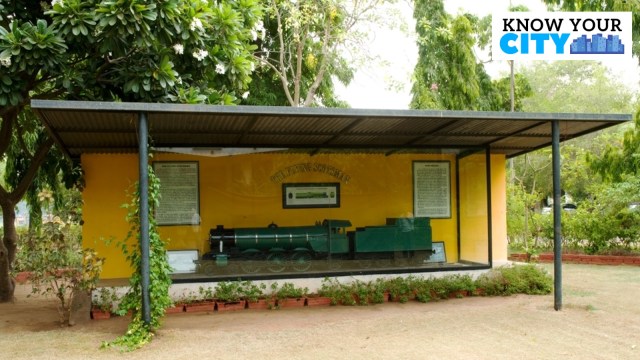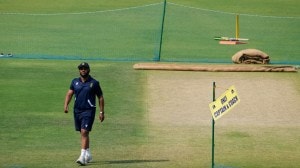Know Your City: Vadodara’s royal heirloom – the scaled Flying Scotsman
Gifted by the Baroda Gaekwad royal family to the children of the city in 1956, the Flying Scotsman train ran for over 53 years along a 2.5km stretch in Sayajibaug
 The train was originally used by the children of the royal family to travel from the Lukshmi Vilas Palace to their royal school on the campus – the building where Maharaja Fatehsinh Museum currently stands. (Express Photo)
The train was originally used by the children of the royal family to travel from the Lukshmi Vilas Palace to their royal school on the campus – the building where Maharaja Fatehsinh Museum currently stands. (Express Photo)Late in January this year, the Vadodara Municipal Corporation (VMC) ordered the Sayaji Express Joy Train running inside the Sayajibaug garden (Kamatibaug) to be suspended for inspection and certification, in the wake of the January 18 Harni Boat tragedy that killed 14 people including 12 students and two teachers. The Joy Train being temporarily pulled off its tracks has disappointed patrons, as Sayajibaug has always been known for its ‘joy train rides’ that began in 1956 with one of the four coveted 1:10 scale models of the then fastest loco trains of Britain – The Flying Scotsman.
Gifted by the Baroda Gaekwad royal family to the children of the city in 1956, the train ran for over 53 years along a 2.5km stretch in Sayajibaug that took 20 minutes to complete. Pulled by the LNER Gresley A3 class Pacific loco, the train had three coaches with a seating capacity of 30. The train was originally used by the children of the royal family to travel from the Lukshmi Vilas Palace to their royal school on the campus – the building where Maharaja Fatehsinh Museum currently stands.
In 1941, Maharaja of Baroda Pratapsinhrao Gaekwad brought an unusual gift for his children. It was the scale model of the Flying Scotsman train that would take the young princes and princesses around the palace grounds.
A three-kilometre-long mini railway track was laid on the Lukshmi Vilas Palace grounds. The train made its first run in 1941, on the third birthday of Maharaja Ranjitsinh Gaekwad. The train circled the orchards before returning to the palace at the end of the day’s school for the royal children. The royal family decided to gift the train to the children of Baroda through the Vadodara Municipal Corporation (VMC). The VMC transferred the tracks earlier laid in the Palace campus to Sayajibaug Park so that the children of the city could enjoy the joy rides in the park.
 Gifted by the Baroda Gaekwad royal family to the children of the city in 1956, the Flying Scotsman train ran for over 53 years along a 2.5km stretch in Sayajibaug. (Express Photo)
Gifted by the Baroda Gaekwad royal family to the children of the city in 1956, the Flying Scotsman train ran for over 53 years along a 2.5km stretch in Sayajibaug. (Express Photo)
Inside Sayajibaug, the train departed from the platform known as ‘Ajyabghar’— which is now used for the Sayaji Express and had been renamed as Swami Vivekanand Station – and passed through the floral clock, Planetarium, and the gardens before heading through a 50-feet-long tunnel and along the bird enclosures in the zoo. The steam engine would halt at the ‘Pankhinagar’ stop to refill its water tank. However, when the steam engine was replaced, the pitstop came to an end. The train was also featured in the song ‘Chakke Mein Chakka’ from the 1968 movie Brahmachari, which starred Shammi Kapoor.
According to the Maharaja Fatehsingh Museum – where the loco currently stands on display – it was built by Mr Bullock, the owner of Surrey Border and Camberley Railway (SB&CR) in 1936. This locomotive was a scale model of LNER Gresley A3 class Pacific (the London and North Eastern Railway) and was initially named Harvester. The original Harvester prototype was one of the engines that pulled the famous Flying Scotsman Train. In the 1940s, the Flying Scotsman was the most popular train among the LNER community running between London and Edinburgh. The locomotive hauling the train also came to be known as the Flying Scotsman.
In 1993, the boiler of the steam engine malfunctioned and the original engine was returned to a shed. On May 15, 2003, the original toy steam engine, The Flying Scotsman, returned to its original home – the Maharaja Fatehsingh Museum. The engine – one of the world’s smallest – was restored by British experts called in by Late Maharaja Ranjitsinh Gaekwad and displayed at the Museum. In 2013, when the VMC decided to replace the train with the current Sayaji Express Joy Train, the royal family requested the VMC to hand over the three coaches to the Maharaja Fatehsingh Museum so that the entire train could be put up on display at the museum, especially since it had “emotional value” for the family.
 In 1941, Maharaja of Baroda Pratapsinhrao Gaekwad brought an unusual gift for his children. It was the scale model of the Flying Scotsman train that would take the young princes and princesses around the palace grounds. (Express Photo)
In 1941, Maharaja of Baroda Pratapsinhrao Gaekwad brought an unusual gift for his children. It was the scale model of the Flying Scotsman train that would take the young princes and princesses around the palace grounds. (Express Photo)
Manda Hingurao, the curator of Maharaja Fatehsingh Museum, said, “The royal family is keen to have the coaches back for display due to the sentimental value attached to the train. The VMC, however, has not yet returned the coaches. Last year, we wrote to the VMC to gently remind them to consider our request and hand over the bogeys so that the train can be displayed in the museum.”
The last run of the Flying Scotsman inside Sayajibaug was celebrated in 2013, with the VMC cutting a cake and distributing chocolates to all the passengers of the last run. The current Sayaji Express is run by a Euro III locomotive made by Seven Lamb, a UK-based company. The train has four coaches with a seating capacity of 36 people and unlike the original Flying Scotsman, the new Sayaji Express can also carry adults around the garden.







